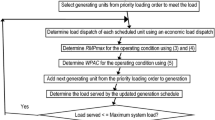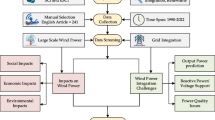Abstract
Wind generation presents variability on every time scale, which must be accommodated by the electric grid. Limited quantities of wind power can be successfully integrated by the current generation and demand-side response mix but, as deployment of variable resources increases, the resulting variability becomes increasingly difficult and costly to mitigate. We model a co-located power generation/energy storage block which contains wind generation, a gas turbine, and fast-ramping energy storage. Conceptually, the system is designed with the goal of producing near-constant “baseload” power at a reasonable cost while still delivering a significant and environmentally meaningful fraction of that power from wind. The model is executed in 10 second time increments in order to correctly reflect the operational limitations of the natural gas turbine. A scenario analysis identifies system configurations that can generate power with 30% of energy from wind, a variability of less than 0.5% of the desired power level, and an average cost around $70/MWh. The systems described have the most utility for isolated grids, such as Hawaii or Ireland, but the study has implications for all electrical systems seeking to integrate wind energy and informs potential incentive policies.
Similar content being viewed by others
References
Apt, J.: The spectrum of power from wind turbines. J. Power Sources 169(2), 369–374 (2007)
GE Energy: Heavy Duty Gas Turbine Products. Retrieved 5 3, 2010, from GE Energy—F Class: (2009) http://www.gepower.com/prod_serv/products/gas_turbines_cc/en/downloads/GEA12985H.pdf
Kim, J., Song, T., Kim, T., Ro, S.: Dynamic simulation of full startup procedure of heavy-duty gas turbines. J. Eng. Gas Turbines Power 124(3), 510–516 (2002)
Castronuovo, E.D., Lopes, J.A.P.: On the optimization of the daily operation of a wind-hydro power plant. IEEE Trans. Power Syst. 19(3), 1599–1606 (2004)
Greenblatt, Succar, Denkenberger, Williams, Socolow: Baseload wind energy: modeling the competition between gas turbines and compressed air energy storage for supplemental generation. Energy Policy 35, 1474–1492 (2007)
Katzenstein, W., Apt, J.: Air emissions due to wind and solar power. Environ. Sci. Technol. 43(2), 253–258 (2009)
Ummels, Pelgrum, Kling: Integration of large-scale wind power and use of energy storage in the Netherlands’ electricity supply. IET Renew. Power Gener. 2(1), 34–46 (2007)
Black, Strbac: Value of bulk energy storage for managing wind power fluctuations. IEEE Trans. Energy Convers. 22(1), 197–205 (2007)
McDowall, J.: Integrating energy storage with wind power in weak electricity grids. J. Power Sources 162, 959–964 (2006)
Wan, Y., Bucaneg, D.: Short-term power fluctuations of large wind power plants. In: 21st ASME Wind Energy Symposium, Reno, NV, 2002
EPRI-DOE: Handbook of Energy Storage for Transmission or Distribution Applications. EPRI-DOE (2002)
NGK Insulators: Overview of NAS battery for load management. In: CEC Energy Storage Workshop (2005)
Wiser, R., Bolinger, M.: 2008 Wind Technologies Market Report. US DOE (2008)
DeCesaro, J., Porter, K., Milligan, M.: Wind energy and power system operations: a review of wind integration studies to date. Electr. J. 22(10), 34–43 (2009)
EIA: Natural Gas Navigator. Retrieved 12 7, 2009, from US Energy Information Administration. http://tonto.eia.doe.gov/dnav/ng/hist/n3035us3m.htm (2009, 10 30)
ERCOT: ERCOT Protocols, Section 6: Ancillary Services. Retrieved Nov 27, 2009, from ERCOT—Current Protocols. http://www.ercot.com/mktrules/protocols/current (2009, Oct 28)
Morthorst: Wind power and the conditions at a liberalized power market. Wind Energy 6, 297–308 (2003)
Department of Communications: Marine and Natural Resources. (2004). Renew. Electr. (2010)
Kanter, J.: A Record for Wind in Ireland. Retrieved December 15, 2009, from Green, Inc. blog—NYTimes.com. http://greeninc.blogs.nytimes.com/2009/08/11/a-record-for-wind-in-ireland/ (2009, August 11)
HECO: Power Facts. Retrieved December 17, 2009, from Hawaii Electric Company. http://www.heco.com/vcmcontent/StaticFiles/pdf/PowerFacts_07-2009.pdf (2009, July)
State of Hawaii: Energy Agreement Among the State of Hawaii, Division of Consumer Advocacy of the Department of Commerce & Consumer Affairs, and Hawaiian Electric Companies (2008)
DOE/NETL: Cost and Performance Baseline for Fossil Energy Plants—Volume 1: Bituminous Coal and Natural Gas to Electricity (2007)
Lazard: Levelized Cost of Energy Analysis—Version 2.0. Presentation at NARUC (2008)
Author information
Authors and Affiliations
Corresponding author
Rights and permissions
About this article
Cite this article
Hittinger, E., Whitacre, J.F. & Apt, J. Compensating for wind variability using co-located natural gas generation and energy storage. Energy Syst 1, 417–439 (2010). https://doi.org/10.1007/s12667-010-0017-2
Received:
Accepted:
Published:
Issue Date:
DOI: https://doi.org/10.1007/s12667-010-0017-2




